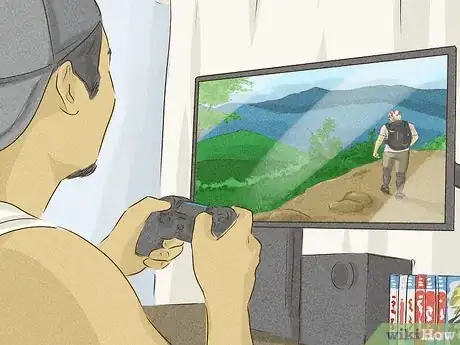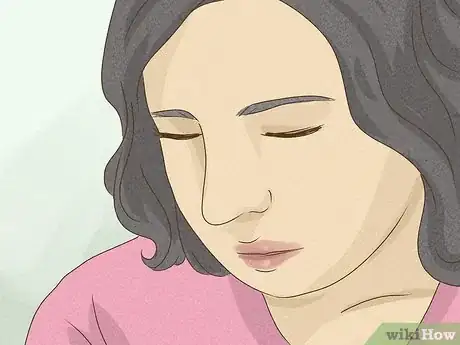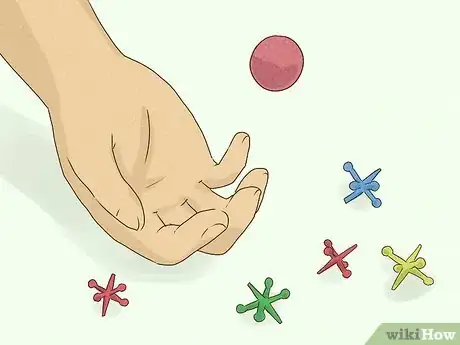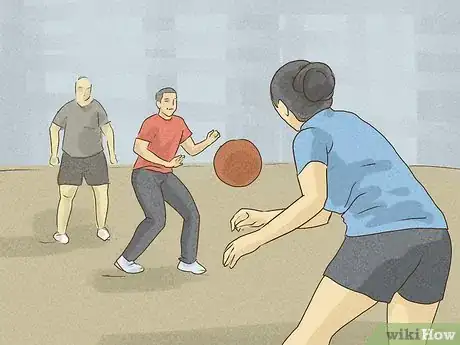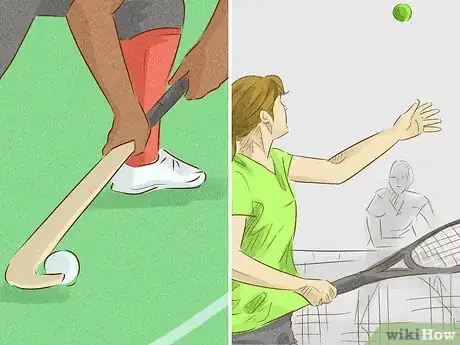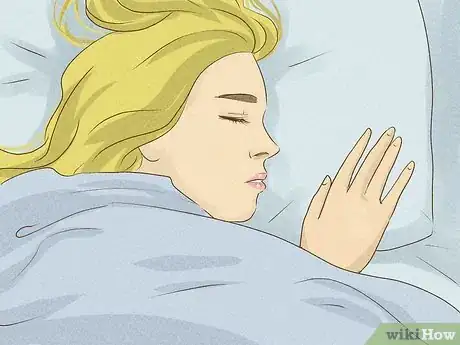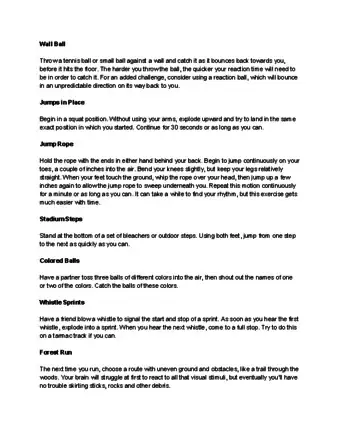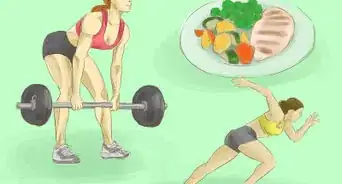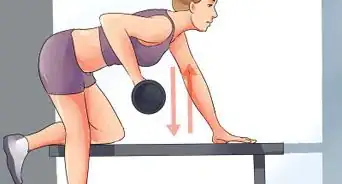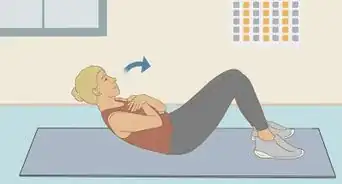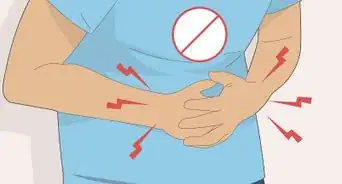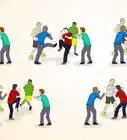This article was co-authored by Isaac Hess. Isaac Hess is a Baseball Coach, Instructor, and the Founder of MADE Baseball Development and Champion Mindset Training Program, a baseball training program based in Los Angeles, California. Isaac has over 14 years of experience coaching baseball and specializes in private lessons and tournaments. He has played baseball for both professional and collegiate leagues including Washington State University and the University of Arizona. Isaac was ranked as one of Baseball America's top 10 prospects for 2007 and 2008. He earned a BS in Regional Development from the University of Arizona in 2007.
There are 8 references cited in this article, which can be found at the bottom of the page.
wikiHow marks an article as reader-approved once it receives enough positive feedback. In this case, 94% of readers who voted found the article helpful, earning it our reader-approved status.
This article has been viewed 855,359 times.
Reflexes are nerve signal-induced muscular reactions to external stimuli. For example, if you spot a baseball flying toward your head, your brain will send a signal to your hand to block the ball before it can hit you. Having good reflexes aids performance in sports, exercise, and everyday physical activities like crossing the street or driving. Some people are born with fast reflexes, and others must practice to attain a quicker reaction time to stimuli. Here are several techniques that can be employed to improve your reflex time.
Steps
Mental Exercises
-
1Improve your peripheral vision. Having a quick reaction time is dependent on being keenly aware of what’s coming. You can strengthen your ability to perceive obstacles and flying objects by paying more attention to your peripheral vision during everyday activities.
- Look out a window that has a good view and focus your vision on a distant object. Keep looking at this object while you slowly let yourself become more aware of the objects that surround it on either side. Do this exercise once a day, widening your field of vision a little more each time. Gradually, you’ll get in the habit of noticing more objects in your peripheral vision.
- Check out the video below for martial arts techniques used to improve peripheral vision.
Tip: While taking a walk or riding in a car, make a point of noticing objects that pop up in your peripheral vision. Practice naming the color of people's hair and the make and model of passing cars as fast as you can.
-
2Play video games. Playing video games well requires good hand-eye coordination. You must be able to move from thought to action without pause, or you’ll quickly lose the game. Studies show that playing video games for a few minutes each day can help improve reflexes. First person shooters and role-playing games often require the most coordination, but any video game will do the trick.[1]Advertisement
-
3Try hypnosis. Some people have found that a hypnosis technique called neuro-linguistic programming helps increase their awareness of a particular object, giving them the sensation that time has slowed down and they have more than enough time to react. Picture a sports movie that shows a quarterback watching a football arc toward him in slow motion. The football is not actually moving more slowly, of course, but according to its practitioners, neuro-linguistic programming can make it seem that way.
-
4Practice mindfulness. Cultivate mindfulness through regular meditation or by focusing on the present moment. Clear your head and try to focus all of your attention on what is happening directly around you. Dismiss thoughts of the past or future and instead focus directly on the sights, sounds, and sensations in the current moment.[2]
This will help you build awareness of surroundings that will allow you to notice more and potentially react more readily in situations.
Physical Exercises
-
1Run a nature trail. Since it requires no special equipment or exercise partners, running in the woods may be the easiest way to begin improving your reflexes. Simply find the closest nature trail—preferably one with varied terrain, rather than a wide, flat path—and start running. The uneven footing and unpredictable roots and rocks you’ll dodge will create a variety of stimuli to which your body will have to quickly react. The more often you hit the trail, the quicker your reflexes will get.
- Begin by running at a slow speed. As you feel your reflexes improve over time, push yourself to run faster. Nature trails have a generally higher risk of injury, so it's important to start slow.
- Mix things up by choosing a different trail whenever possible. If you get too used to one particular trail, your brain will remember obstacles, and you won’t be improving your reflexes.
- Run the same trail in the other direction if you don’t live close to many nature trails.
-
2Practice catching a rubber bouncy ball. Rubber bouncy balls, sometimes referred to as "reaction balls," are 6-sided rubber balls that bounce at unpredictable angles. They may be purchased at most sporting goods stores. Take one of these, or a simple quarter-machine bouncy ball, and toss it against an outdoor wall.
- Focus on catching the ball as it bounces back in your direction. Once your reflex time improves, throw the ball harder, challenging yourself to leap and dive to catch it.
-
3Play jacks. For the days when you’re feeling more low-key, grab a set of jacks. This classic children’s game comes with a small ball and 12 metal pieces. Start by lightly bouncing the ball and picking up as many jacks as possible. As you get better at the game, challenge yourself by bouncing the ball with greater speed. You may also spread the jacks farther apart to increase the game’s difficulty.
-
4Play dodgeball with a partner. For this exercise, you need a large rubber or foam ball and a friend. Stand in front of a wall, either in a gym or outside in front of a building. Have your partner pitch the ball at you from about 10 feet (3.0 m) away while you practice dodging it. As you get better at dodging the ball, ask your partner to throw it faster and from a closer distance.
- To make this exercise more difficult, recruit a second pitcher to throw another ball quickly after you have dodged the first one.
- Ask the pitchers to increase unpredictability by faking throws, throwing from different angles, and so on.
- Playing dodgeball as a team sport is also a great way to improve your reflexes. Practice fielding balls and kicking those that are pitched to you.
-
5Try table tennis. Table tennis, or ping pong, is a great sport to help you improve your reflexes and hand-eye coordination. You can find tables or tabletop setups relatively affordably online or at many sporting goods stores. Alternatively, you can join a local table tennis group or club, which will allow you to face off with different partners and take on greater challenges as you work to improve your reflexes.[3]
If you have never played table tennis before, a local club or group might be beneficial, as they can help you understand the basics of the game including form and skill-building.
-
6Pick a sport to practice regularly. Many sports, including hockey, tennis, badminton, racquetball, and lacrosse, are great activities to help you build your reflexes. Look for an athletic activity where you have to manipulate an object, such as a ball, using a tool, such as a racket or stick. These sports generally require quick reactions, and can help you build both reflexes and situational awareness.[4]
-
7Try slow sparring to improve your fighting reflexes. If you play combat sports, like boxing or karate, then slow sparring can be a great way to develop the muscle memory you need to perform your moves faster. Start by practicing your moves with a partner in a slow and deliberate way. As they start to become more automatic, you can gradually speed up.
- Whether you’re sparring in slow motion or at full speed, staying relaxed is key. Before you start a sparring match, take some time to meditate or do deep breathing exercises to help you unwind and stay focused.[5]
Self Care
-
1Eat nutritious food. Keeping your body and brain in optimal shape is imperative if you want quick reflexes. Foods high in refined sugars and trans fats can make you feel sluggish. Make sure you are getting enough protein, complex carbohydrates, and healthy fats.
- Whole foods like nuts, fish, berries, greens, and garlic increase cognitive function.[6]
- Make sure to drink plenty of water as well, since dehydration can also lead to lethargy and decreased reflex times.
-
2Get plenty of sleep. According to the National Institutes of Health (NIH), sleep helps you have quicker reflexes and perform on a higher level than you otherwise would.[7] Both your body and brain slow down when you’re sleepy, resulting in impaired reflex reactions. Your reflexes will be quickest when you’re well-rested after 7 to 9 hours of sleep.
- A good night's sleep is made up of 4 or 5 sleep cycles, each of which consist of a period of deep sleep and rapid eye movement (REM) sleep. This adds up to 7 to 9 hours per night.
- If you didn't sleep well the night before an important race or game, taking a nap a few hours before the event will help you be more alert when it's time to perform.
-
3Consider supplements. Certain nutritional supplements are said to lead to improved reflexes. Ginseng, gingko, vitamin B12, vitamin C, and omega 3 fatty acids have all been cited as dietary supplements that may be worth taking for better cognitive function and reaction times.
Sample Exercises to Improve Reflexes
Expert Q&A
Did you know you can get expert answers for this article?
Unlock expert answers by supporting wikiHow
-
QuestionCan you improve your reaction time?
 Michele DolanMichele Dolan is a BCRPA certified Personal Trainer in British Columbia. She has been a personal trainer and fitness instructor since 2002.
Michele DolanMichele Dolan is a BCRPA certified Personal Trainer in British Columbia. She has been a personal trainer and fitness instructor since 2002.
Certified Fitness Trainer
-
QuestionDespite of my interest in sports, I couldn't do good at any sport at school because I am very uncoordinated. How can I get well coordinated?
 Michele DolanMichele Dolan is a BCRPA certified Personal Trainer in British Columbia. She has been a personal trainer and fitness instructor since 2002.
Michele DolanMichele Dolan is a BCRPA certified Personal Trainer in British Columbia. She has been a personal trainer and fitness instructor since 2002.
Certified Fitness Trainer
-
QuestionHow do you test your reflexes?
 Michele DolanMichele Dolan is a BCRPA certified Personal Trainer in British Columbia. She has been a personal trainer and fitness instructor since 2002.
Michele DolanMichele Dolan is a BCRPA certified Personal Trainer in British Columbia. She has been a personal trainer and fitness instructor since 2002.
Certified Fitness Trainer
Warnings
- Check with your doctor before taking new dietary supplements, as some should not be taken by people with certain medical conditions.⧼thumbs_response⧽
- You may want to consider wearing protective eyewear, such as sports goggles, when performing ball-throwing exercises.⧼thumbs_response⧽
- Sluggish or absent reflexes can sometimes be a sign of a problem with your nervous system, such as damage to your nerves or spinal cord. If you’re concerned about your reflexes, see your doctor for an exam and testing.[8]⧼thumbs_response⧽
Things You'll Need
- Running or trail running shoes
- A rubber bouncy ball, tennis ball, or "reaction" ball
- A large rubber or foam ball
- A computer or video game console
References
- ↑ http://www.gizmag.com/video-games-increase-decision-making-abilities/16397/
- ↑ https://www.psychologytoday.com/blog/the-courage-be-present/201002/practicing-mindfulness-without-meditating
- ↑ http://www.healthfitnessrevolution.com/top-10-health-benefits-ping-pongtable-tennis/
- ↑ http://www.active.com/tennis/articles/4-ways-to-improve-your-reaction-speed
- ↑ https://www.theguardian.com/lifeandstyle/2018/oct/01/seven-ways-to-improve-your-reflexes
- ↑ http://www.huffingtonpost.com/2012/09/18/brain-food-superfoods_n_1895328.html
- ↑ http://newsinhealth.nih.gov/issue/apr2013/feature1
- ↑ https://www.urmc.rochester.edu/encyclopedia/content.aspx?ContentTypeID=1&ContentID=562
About This Article
To improve your reflexes, start by tossing a rubber bouncy ball against a wall and practice catching it as it bounces back in your direction. You can also play a sport that requires quick reaction times, such as ping pong or racquetball, or you can run nature trails where your body has to quickly adjust to uneven terrains. Alternatively, try playing video games to develop faster hand-eye coordination. Additionally, make sure you get at least 7 hours of sleep each night so that your body is well-rested and alert. For more tips from our Fitness reviewer, like how to change your diet to improve your reflexes, read on!

